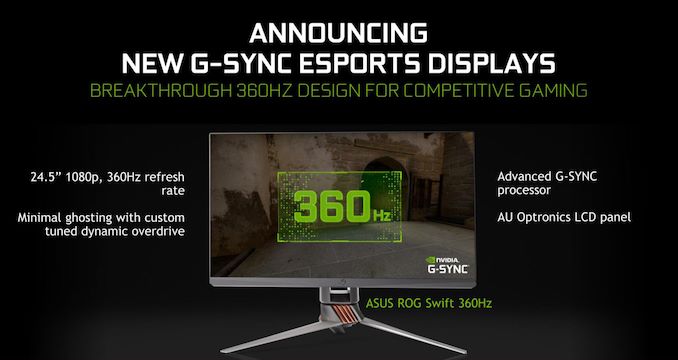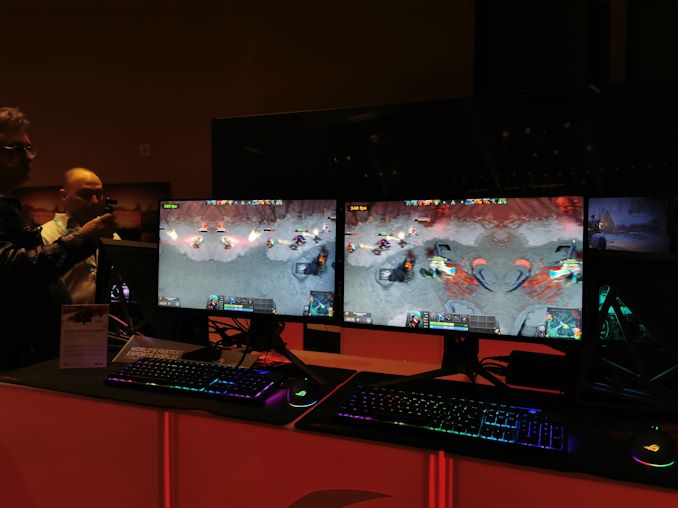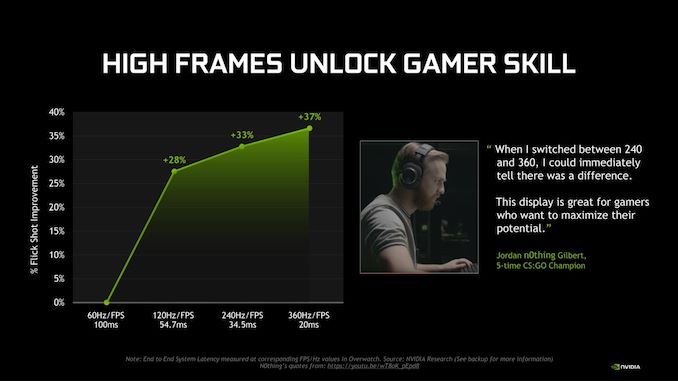NVIDIA & ASUS Unveil 360Hz 1080p G-Sync Monitor: ROG Swift 360
by Ryan Smith on January 5, 2020 9:00 PM EST- Posted in
- Monitors
- Asus
- ROG
- 1080p
- Trade Shows
- NVIDIA
- G-Sync
- AU Optronics
- CES 2020
- 360Hz

Even though CES proper doesn’t kick off for one more day, NVIDIA and ASUS are getting in an announcement a bit ahead of the curve relating to a new monitor. The two companies have been working on a new high-performance 1080p display aimed at competitive gaming that offers a blistering 360Hz maximum refresh rate, 50% faster than the current crop of 240Hz market leaders. The new monitor will be sold by ASUS as the ROG Swift 360, and is set to be available later this year.
Like other G-Sync projects, NVIDIA’s latest display endeavor looks to be an effort for the company to differentiate itself and its technology in a crowded market, this time by offering an LCD monitor with a rather absurd refresh rate.
The ROG Swift 360 itself is based on a 24.5-inch panel being supplied by AU Optronics, and which is capable of running at up to 360Hz. This is 120Hz faster than the current generation of high-end gaming monitors, which top out at 240Hz, and is an uncommonly large jump to make in a single generation. Unfortunately NVIDIA isn’t disclosing what type of panel is being used here, however all of the 24.5-inch 240Hz G-Sync monitors that have been released to date have been TN, so that’s a safe bet, especially with the kind of refresh rate NVIDIA and ASUS are looking to hit. The bigger question is whether this is a new panel from AUO, or if it’s a further overclocked version of their popular M250HTN01 panel.
NVIDIA and ASUS have not released much else with regards to technical details at this time. The monitor isn’t set to ship until later this year – which as we’re at the very start of the year, likely means it’s still several months off – so the companies undoubtedly still have some technical details to hammer out. Though as most of the work is in the panel and controller, it shouldn’t be too different from ASUS’s 240Hz ROG Swift PG258Q.

ASUS 360 Hz on left, 240 Hz on right. It is a TN Panel
One thing that NVIDIA has confirmed, however, is that this will be a true G-Sync monitor, with NVIDIA supplying the monitor’s display controller. This is an important distinction not only for compatibility purposes, but because it means that the monitor supports full variable overdrive functionality, which will become increasingly important with such a wide refresh rate range. Even fast TN monitors still need to overdrive their pixels to hit high refresh rates, so the overdrive logic is practically as important as the panel itself in order to minimize ghosting. Though it goes without saying that with NVIDIA aiming to beat current generation monitors by 50%, it’ll be interesting to see just how well 360Hz works in practice, and if the monitor really is fast enough to make a 360Hz refresh rate useful.
The target market for the ROG Swift 360, in turn, is competitive gaming, as well as anyone who wants a competition-grade monitor. The benefits of higher refresh rates are pretty well known at this point – higher refresh rates make for smoother experiences and reduce rendering latency – and NVIDIA thinks that there’s still enough benefit to justify a 360Hz monitor. That said, with 240Hz monitors offering an already tiny 4.16ms frame time, the absolute benefit of 360Hz is small: that 50% jump in refresh rate only shaves off a further ~1.4ms at the monitor level (for a total of 2.77ms), which isn’t nearly as great as the jump from 60Hz to 120Hz, for example.
Still, NVIDIA has done their own research around the new monitor and player performance, finding that even with the diminishing returns, a 360Hz monitor did improve flick shot performance in Overwatch. As well, they measured a 14.5ms reduction in total (end-to-end) latency, going from 34.5ms at 240Hz to 20ms at 360Hz.
NVIDIA and ASUS will have the ROG Swift 360 on display this week at CES. So while the monitor won’t be on sale for a while yet, we should be able to get a first-hand look at how well NVIDIA’s future gaming monitor is set to perform.
Source: NVIDIA











38 Comments
View All Comments
Sychonut - Sunday, January 5, 2020 - link
360Hz? Who cares dawg, who cares? Another unnecessary "need" created to drive up sales.willis936 - Sunday, January 5, 2020 - link
It’s important and it’s nice to see progress in temporal resolution pushed. Refresh rates already push past what LCDs can handle. 360 Hz is well into OLED territory. A 360 Hz consumer OLED: now that would be cause to sit up in one’s seat.surt - Sunday, January 5, 2020 - link
Who cares? High end gamers looking for an edge. Every ms in end-to-end latency matters.A5 - Monday, January 6, 2020 - link
There are probably a handful of people in the world that can tell the difference between 240 and 360 once they're in-game.JoeyJoJo123 - Monday, January 6, 2020 - link
240hz is already a subtle difference to 120/144. Also, it's not about whether you can "tell" the difference or not, because ultimately, you need to practice with your mouse, your keyboard, your desk, your monitor -- your entire setup, and often any change to anything involves some personal retraining to get used to the new change. Ordinarily you could just people in a double-blind study (and have them guess which monitor is 240hz and which is 360hz), but really you need way more time to get attuned with the peripheral.Often times, pros are pros because they're highly attuned to their setup and can minimize the human element of ingesting information (time taken to digest what's happening on the monitor/sounds heard from headphones) and especially minimizing the human element of interacting with input elements (controller/mouse/keyboard/arcade stick/wheel+pedals/etc).
It's as naive of an idea as just going up to a fighting game pro like Daigo Umehara, taking their arcade stick and giving them a 3rd party MadCatz controller and saying "Hey, if you're so pro, then you should be able to win with this." No, it doesn't work like that, you need to actually get used to it before you can really start noticing any differences.
By the same token having 5 minutes to try to compare the two monitors really isn't enough time. You need to let it sit and boil for like a month and see if they prefer the new 360hz monitor over the old one.
Additionally, as refresh rates (and brightness) increase ever higher, you can start implementing black frame insertion on every other frame through software, while still keeping a good enough effective refresh rate. Losing every other frame at 360hz = 180hz + low display persistence (diminished ghosting/motion blur), and that lowered motion blur may help a bit more than the additional slight smoothness from 240hz->360hz.
So there's a lot of stuff to consider before we go about dismissing 360hz just because "the human eye can't see past 23.998 fps cinema movies" memes.
crimsonson - Monday, January 6, 2020 - link
Daigo can pick the stick he uses in a tournament. Monitors are something the organizers pick because sponsors pay for them.It is not an apt analogy.
mdrejhon - Tuesday, January 7, 2020 - link
One wants to jump up the Hz curve geometrically.60Hz->144Hz and 144Hz->360Hz are similar percentage jumps.
Benefits are most noticeable this way in the curve of diminishing returns. Tests have shown that the diminishing curve still has benefits to well beyond 1000Hz.
PeachNCream - Monday, January 6, 2020 - link
True statement. Within a product category there is a need to fight a specifications war to land sales and the current specifications battle has settled around refresh rate. Manufacturers NEED to create a reason behind the specifications or no one will care. In this case the industry consensus is to impress upon gullible customers that a higher refresh rate will improve their competitive gameplay so that they crawl out of their parents' basement to beg their parents to spot them a few hundred dollars for a new monitor just until they can get a few more Grubhub deliveries done and can pay them back or finally win that one vidja games tournament with said monitor.Spunjji - Monday, January 6, 2020 - link
There's some interesting information on this topic available on specialist sites covering motion blurring in displays... In short, the closer we get to ~1000Hz, the less motion blur is visible on sample-and-hold displays - all while avoiding the brightness reduction of blank-frame-insertion.willis936 - Monday, January 6, 2020 - link
No reason to cover up information. The site is tft central.